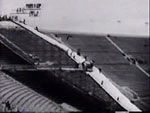 |
||
 |
 |
|
![]()
|
The History of Skiing in Los Angeles, California It's hard to imagine but there was skiing in Los Angeles where never a snowflake has fallen. The history of Southern California skiing is peopled with a cast of characters and events as colorful as any to set foot on a Hollywood soundstage. Downtown Los AngelesThere were men like Vicki (Ludvig) Hasher, a Bavarian import who found his way to Los Angeles in 1927 and hooked up with a group of Norwegians who called themselves the Viking Ski Club of Los Angeles. In 1931, Hasher won the first official cross-country ski competition held by the newly-formed California Ski Association (later Far West Ski Association). But perhaps the most memorable contribution California’s first ski champion made to the sport was his novel way of introducing skiing to new fans. Somehow Hasher convinced the people at the May Company department store to install a ski slide high atop their building in downtown Los Angeles. Hasher taught a bevy of beautiful movie stars, not to mention everyday people, to ski on a surface sprinkled with rice hulls, borax and salt that was 15 foot wide and 84 foot long. The slide had a less-than-breath-taking vertical drop of 16 feet, but it attracted plenty of people to the sport of skiing. That was back in 1937 when the May Company was advertising a handsome assortment of hickory and maple skis for $4.95 to $25. Poles started at $1.95 and bindings at $2.95. American and European ski boots sold for the princely sum of $6.95 to $18.50. Hollywood BowlIn 1935, thousands of spectators wearing mufflers and sweaters were thrilled by the chills and spills of a ski jumping competition on a canyon slope off the Hollywood Bowl, of all places. Tons of snow was trucked in from the mountains for the occasion. Olaf Telleffsen of the Viking Ski Club won the Class A division with a leap of 120 feet. Among the competitors was Johnny Elvrum, who held the American ski jumping record of 240 feet for a heady five years, until Alf Engen came along. Johnny later joined the Los Angeles Viking Ski Club and subsequently opened Snow Valley Ski Area in Big Bear. Los Angeles ColiseumA similar competition was held at the Coliseum in 1938, on a man made slide towering 60 feet over one end of the stadium seats, its runway sloping down onto the football field. Ice machines sprayed 500 tons of ice crunched into snow over the area. Dodger StadiumA ski jumping competition and dual slalom races were held on a man-made scaffold and ski slope at Dodger Stadium as recently as 1962. The Los Angeles Country Fair in PomonaIn 1951, the world's largest man-made ski jump using articial snow was built at the LA Country Fair in Pomona. The take off rose 225 feet high and sloped downward for 500 feet. In 1960, the Fair again presented a ski jump performance on a man-made jump covered with artificial snow. The Hills of Los AngelesJoe Diener, one of the 12 members of the San Gorgonio Ski Club who scratched Kratka Ridge out of the mountain in 1950, remembers when going skiing took imagination, ingenuity and just plain hard work. Years ago, if you didn’t pack the hill where you went skiing, you didn’t ski. You had to earn your ride down by hiking up, a dismal state of affairs that begged for a better solution. Creative-thinking skiers, therefore devised various methods of conveyance to haul themselves up hill with a minimum of effort. There was a rope tow pulled by a horse, for example. And a ski bus which was a monstrosity. Yosemite had a boat-like contraption in the late thirties that took about 30 people up the hill at the same time. Of course, you could always drive the old auto up and draw straws to see who would be the lucky one to drive back down and pick up the skiers at the bottom. In about 1939, Snow Valley had one of the first overhead cable lifts, featuring attachments that looked like a child’s swing and transported ten people at a time. In 1942, Lynn Newcomb, Sr. put Southern California's first chairlift in at Mt. Waterman. Check out our developing timeline of skiing in Southern California. photos courtesy California Ski Library, Ingrid Wicken collection. |
||||||||||||||||||||

Coliseum Ski Jump 1938 |

Pomona Fair Ski Jump 1951 |

Dodger Stadium Jum 1963 |

Dryland Training in Los Angeles |

Tyler & Ethel VanDegrift |
Email us at info@pacificrimalliance.org
Contents of this site Copyright © 1997-2019 by Pacific Rim Alliance. All rights reserved.
Site designed & maintained by Graphic Dezignz. Last updated October 17, 2017.
 |
 |
Skiing is a Dance in which the Mountain always Leads
